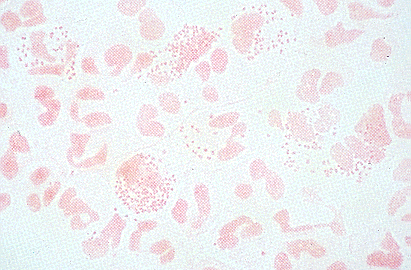NEISSERIA
NEISSERIA
(under the microscope)
 The Neisseria genus consists of aerobic, non-spore-forming Gram-negative diplococci which inhabit
the mucous membranes of many animals (and humans). These non-motile microbes require a moist environment
and warm temperatures (human body temperature range) to achieve optimum growth. An important means of
identification of Neisseria species is the oxidase test, for which all members test positive.
Additionally, Neisseria grow well on chocolate agar containing antibiotics that inhibit growth
of Gram-negative bacteria, Gram-positive bacteria, and molds. The two most
clinically significant members of Neisseria are N. gonorrhoeae and N. meningitidis.
The Neisseria genus consists of aerobic, non-spore-forming Gram-negative diplococci which inhabit
the mucous membranes of many animals (and humans). These non-motile microbes require a moist environment
and warm temperatures (human body temperature range) to achieve optimum growth. An important means of
identification of Neisseria species is the oxidase test, for which all members test positive.
Additionally, Neisseria grow well on chocolate agar containing antibiotics that inhibit growth
of Gram-negative bacteria, Gram-positive bacteria, and molds. The two most
clinically significant members of Neisseria are N. gonorrhoeae and N. meningitidis.
N. gonorrhoeae
Infection by the diplococcoid bacterium N. gonorrhoeae is referred to as a gonococcal infection.
Gonorrhea is transmitted between humans through intimate contact of the mucous membrane. This sexually
transmitted organism can be carried by men and women for many years without any sign or symptoms.
In infected males, the disease is characterized by a urethral discharge of puss and can eventually result
in other complications such as prostatitis and periurethral abscess. The incubation period of the bacterium
can last from a day to a week. Females infected with gonorrhea exhibit vaginal discharges, abdominal pain,
and abnormal non-menstrual bleeding. Ironically, the widespread use of birth control devices such as the
pill has actually increased the number of gonococcal infections in the United States. Use of the birth control pill
can lower the glycogen concentration of the vaginal membrane. This environmental change inhibits the
growth of acid-producing bacteria, such as Lactobacillus, which are the natural flora of the vagina.
The vaginal pH soon becomes less acidic and a variety of organisms are able to grow there.
As with most other sexually transmitted diseases, gonorrhea is prevalent in young adult and homosexual
populations. This disease may sound really bad, but it is treatable. N. gonorrheae is sensitive
to ultraviolet radiation, drying, and antibiotics. Because chlamydia infection is often associated with a
gonococcal infection, a regimen of ceftriaxone and doxycycline is used to kill both organisms.
LABORATORY INDICATIONS:
- Oxidase +
- Glucose fermentative
N. meningitidis
It doesn't take a genius to figure out that N. meningitidis causes meningitis, inflammation of the
membranes covering the central nervous system. The different strains of N. meningitidis are classified
by their capsular polysaccharides. This bacterium is the second leading cause of meningitis in the United
States. Early symptoms may
include headache, fever, and vomiting. Death can quickly follow due to endotoxin shock or
focal cerebral involvement. Infection doesn't always lead to death, however. The organism can often assume
a carrier status with very few carriers actually developing the disease. Infected patients can be treated
with penicillin, while rifampin may be used profilactically as a means of preventing the disease state in
carriers.




Copyright © 1995 University of Texas - Houston Medical School, DPALM MEDIC, All rights reserved.
 The Neisseria genus consists of aerobic, non-spore-forming Gram-negative diplococci which inhabit
the mucous membranes of many animals (and humans). These non-motile microbes require a moist environment
and warm temperatures (human body temperature range) to achieve optimum growth. An important means of
identification of Neisseria species is the oxidase test, for which all members test positive.
Additionally, Neisseria grow well on chocolate agar containing antibiotics that inhibit growth
of Gram-negative bacteria, Gram-positive bacteria, and molds. The two most
clinically significant members of Neisseria are N. gonorrhoeae and N. meningitidis.
The Neisseria genus consists of aerobic, non-spore-forming Gram-negative diplococci which inhabit
the mucous membranes of many animals (and humans). These non-motile microbes require a moist environment
and warm temperatures (human body temperature range) to achieve optimum growth. An important means of
identification of Neisseria species is the oxidase test, for which all members test positive.
Additionally, Neisseria grow well on chocolate agar containing antibiotics that inhibit growth
of Gram-negative bacteria, Gram-positive bacteria, and molds. The two most
clinically significant members of Neisseria are N. gonorrhoeae and N. meningitidis.



